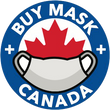Mask Benefits
Proud Canadian ingenuity, locally made and sourced masks and respirators to help North Americans stay safe so we can all return to the normalcy of everyday life.
Masks should be used as part of a comprehensive strategy of measures to suppress transmission and save lives; the use of a mask alone is not sufficient to provide an adequate level of protection against COVID-19.
If COVID-19 is spreading in your community, stay safe by taking some simple precautions, such as physical distancing, wearing a mask, keeping rooms well ventilated, avoiding crowds, cleaning your hands, and coughing into a bent elbow or tissue. Check local advice where you live and work. Do it all!
Make wearing a mask a normal part of being around other people. The appropriate use, storage and cleaning or disposal of masks are essential to make them as effective as possible.
- Clean your hands before you put your mask on, as well as before and after you take it off, and after you touch it at any time.
- Make sure it covers both your nose, mouth and chin.
- When you take off a mask, store it in a clean plastic bag, and every day either wash it if it’s a fabric mask, or dispose of a medical mask in a trash bin.
- Don’t use masks with valves.
Masks Made Of Material
Our masks are made of 100% Polyester or 90% Polyester and 10% Spandex.
Antimicrobial fabric vs Untreated fabric
The photos below are an example of the benefits of antimicrobial fabrics. Under the right conditions, mold and mildew can flourish by using the fabric as a food source. Anti microbial fabrics provide antibacterial and antifungal protection, keeping textiles clean and safe from attack.
Both fabric samples were tested using the AATCC Method 30, Part III using Aspergillus niger as specified by the method. The untreated sample supported heavy amounts of the black mold after seven days of incubation. The anti-microbial fabric is free of fungal growth, maintaining esthetic appeal and tensile strength.
Both fabric samples were tested using the AATCC Method 30, Part III using Aspergillus niger as specified by the method. The untreated sample supported heavy amounts of the black mold after seven days of incubation. The anti-microbial fabric is free of fungal growth, maintaining esthetic appeal and tensile strength.

ORDER NOW
What is antimicrobial?
• The term ‘antimicrobial’ is defined as: “destroying or inhibiting the growth of microorganisms, and especially pathogenic microorganisms.” Microorganisms “include bacteria, viruses, protozoans, and fungi, like mold and mildew.” An antimicrobial is applied to a fabric to help fight off pathogens that could potentially infect a patient. This means that the antimicrobial is constantly working against microorganisms and not only protecting human users, but also prolonging the life of the fabric. Antimicrobial products are common in medical facilities and are used in textiles. Similar to antibacterial soaps and disinfectants, antimicrobial fabrics help reduce the spread of disease.The primary function of antimicrobials is to help prevent bacteria and other microorganisms from attaching to the fabric surface. Keep in mind, microorganisms can live in a fabric and grow. That’s why antimicrobials are so effective -- they prevent the growth and spread of microorganisms within the fabric. This is especially useful in the healthcare industry where exposure to bacteria and other pathogens is possible on a daily, hourly, basis. From beds to pillows, to hospital gowns, and even the scrubs a nurse or doctor wears, fabrics in the healthcare industry must be designed to prevent the spread of disease. That’s why the use of antimicrobial fabrics is so common and so helpful in the places like hospitals.

